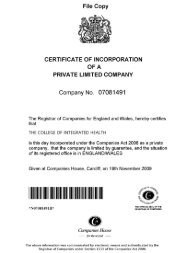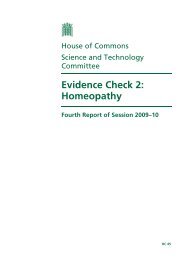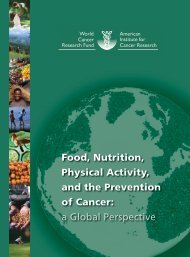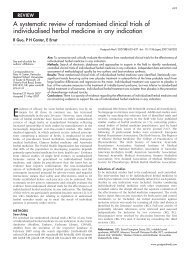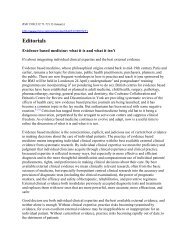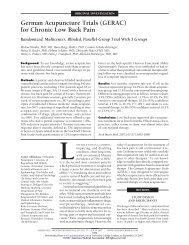Sacks et al., 2009
Sacks et al., 2009
Sacks et al., 2009
- No tags were found...
You also want an ePaper? Increase the reach of your titles
YUMPU automatically turns print PDFs into web optimized ePapers that Google loves.
The new england journ<strong>al</strong> of medicineTable 2. Risk Factors, Nutrient Intake, and Biomarkers of Adherence, According to Di<strong>et</strong>, at 6 Months and 2 Years.*Variable Low Fat, Average Protein Low Fat, High ProteinRisk factors†Cholesterol (mg/dl)6-Mo V<strong>al</strong>ueChangefromBaseline2-YrV<strong>al</strong>ueChangefromBaseline6-Mo V<strong>al</strong>ueChangefromBaseline2-YrV<strong>al</strong>ueChangefromBaselineTot<strong>al</strong> 188±36 –5.9 192±37 –3.7 193±39 –4.9 197±40 –2.9LDL 116±29 –6.6 117±31 –5.9 120±33 –4.8 121±33 –3.9HDL 49±13 –0.4 51±15 5.6 51±13 2.7 53±15 6.5Triglycerides (mg/dl) 116±73 –14.2 120±83 –11.5 114±63 –20.4 120±67 –16.6Blood pressure (mm Hg)Systolic 116±12 –1.2 117±12 –0.8 117±12 –2.6 118±13 –1.7Diastolic 74±9 –1.4 74±9 –0.8 73±9 –3.1 74±9 –1.3Glucose (mg/dl) 90±11 –3.0 94±12 1.1 90±16 –2.6 93±17 1.0Insulin (μU/ml) 10±7 –16.2 12±10 –2.4 10±6 –19.9 11±8 –11.5HOMA 2.3±1.6 –18.7 2.8±2.3 –1.4 2.2±1.6 –22.7 2.5±2.2 –10.4Nutrient intake per dayEnergy (kc<strong>al</strong>) 1636±484 –477 1531±480 –554 1572±568 –353 1560±461 –402Carbohydrate (%) 57.5±11.1 12.8 53.2±11 9.3 53.4±8.5 7.4 51.3±9.2 6.8Protein (%) 17.6±3.4 0.2 19.6±3.9 2.1 21.8±3.8 3.9 20.8±4 2.5Fat (%) 26.2±8 –11.8 26.5±8 –12.0 25.9±6.8 –10.1 28.4±8.1 –8.4Saturated fat (%) 7.5±3.2 –4.9 8±3.1 –4.3 7.9±2.7 –3.9 8.9±3.8 –3.1Biomarkers of adherenceUrinary nitrogen (g)‡ 11.1±4.1 –11.5 11.8±4.6 –9.1 11.9±4.3 –2.5 11.8±3.9 –2.8Respiratory quotient§ 0.84±0.04 0.58 0.83±0.04 –0.48 0.84±0.04 0.16 0.84±0.04 –0.84* Plus–minus v<strong>al</strong>ues are means ±SD. Change from baseline is percent change in the case of risk factors and biomarkers of adherence and actu<strong>al</strong>change in the case of nutrient intake per day. Nutrient intake was d<strong>et</strong>ermined by three 24-hour rec<strong>al</strong>ls. To convert the v<strong>al</strong>ues for cholesterolto millimoles per liter, multiply by 0.02586. To convert the v<strong>al</strong>ues for triglycerides to millimoles per liter, multiply by 0.01129. To convertthe v<strong>al</strong>ues for glucose to millimoles per liter, multiply by 0.05551. HDL denotes high-density lipoprotein, HOMA homeostasis modelassessment of insulin sensitivity, and LDL low-density lipoprotein.† Data were included for 201 participants per group; missing v<strong>al</strong>ues were imputed.‡ Data were included for 200 to 204 participants per group at baseline, 139 to 153 at 6 months, and 88 to 109 at 2 years.§ Data were included for 201 to 204 participants per group at baseline, 157 to 164 at 6 months, and 113 to 132 at 2 years.[P = 0.01]). The lowest-carbohydrate di<strong>et</strong> increasedHDL cholesterol levels more than the highest-carbohydratedi<strong>et</strong> (9% vs. 6%, P = 0.02). All the di<strong>et</strong>sdecreased triglyceride levels similarly, by 12 to 17%.All the di<strong>et</strong>s except the one with the highest carbohydratecontent decreased fasting serum insulinlevels by 6 to 12%; the decrease was larger withthe high-protein di<strong>et</strong> than with the average-proteindi<strong>et</strong> (10% vs. 4%, P = 0.07). Blood pressure decreasedfrom baseline by 1 to 2 mm Hg, with nosignificant differences among the groups (P>0.59for <strong>al</strong>l comparisons). These changes in risk factorsin the intention-to-treat population were about30 to 40% sm<strong>al</strong>ler than the changes seen amongparticipants who provided data at 2 years, reflectingthe effect of the imputation of missing v<strong>al</strong>ues(Table 1 in the Supplementary Appendix). Them<strong>et</strong>abolic syndrome 35 was present in 32% of theparticipants at baseline, and the percentage waslower at 2 years, ranging from 19 to 22% in thefour di<strong>et</strong> groups (P = 0.81 for the four-way comparison).Adherence, Di<strong>et</strong> Acceptability, Sati<strong>et</strong>y,and SatisfactionMean reported intakes at 6 months and 2 yearsdid not reach the targ<strong>et</strong> levels for macronutrients(Table 2). The reported intakes represented differ-866n engl j med 360;9 nejm.org february 26, <strong>2009</strong>Downloaded from www.nejm.org on March 14, <strong>2009</strong> . For person<strong>al</strong> use only. No other uses without permission.Copyright © <strong>2009</strong> Massachus<strong>et</strong>ts Medic<strong>al</strong> Soci<strong>et</strong>y. All rights reserved.




